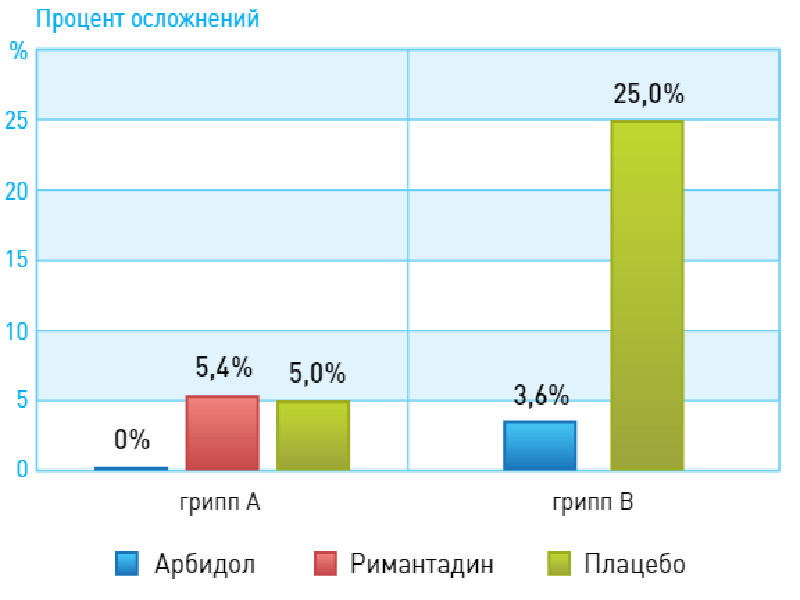According to statistics, autumn and winter are the times when the risk of contracting viral infections and colds is highest. You need to be most careful at these times of the year and try to avoid hypothermia. It is advisable to minimize attendance at public events and crowded places to prevent infection with influenza or ARVI.
Women during lactation need to always be on guard of their health, and especially in the autumn-winter period. If a nursing mother gets sick, it is recommended to immediately seek help from a therapist. He will be able to weigh all the risks of taking medications and prescribe the correct treatment.
How the drug works
Arbidol is aimed at combating viruses, in particular influenza, and coronavirus infection.
The drug contains interferon, which increases the body's resistance to the disease and strengthens the immune system. The same substance is independently produced by the body, but this happens when viruses actively penetrate inside and multiply. The amount of interferon that the body produces is not enough, so medication is necessary. Arbidol just helps to replenish the missing amount of this active substance. It increases the concentration of interferon, after which it begins to actively destroy the compounds of healthy cells and the lipid membrane of viruses.
If interferon is formed in the human body after infection, then Arbidol can be taken in the early stages of the disease, for preventive purposes. In addition, the drug is often recommended to be taken after contact with an infected person or after surgery to prevent the development of complications.
Composition and mechanism of action of the drug
The principle of action of the drug on the body is based on the suppression of viruses and stimulation of the immune system. The main active ingredient of the drug is synthetic interferon, umifenovir. The medicine is available in the form of capsules coated with a protective shell. The product forces the immune system to actively resist the effects of viruses, creating a reliable protective barrier.
The main effect of the composition is to suppress the signs and eliminate the symptoms of the disease. The drug promotes general relief of the condition.
Nursing mothers have a weakened immune system, which has significantly lost its protective abilities during pregnancy, childbirth, and feeding the baby. There are no clinical studies regarding the safety of the composition. Opinions regarding the safety of the substance are quite contradictory.
Opponents of use are based on the specific composition of the drug. In their opinion, artificial interferon suppresses the natural production of antibodies in the body and affects the external signs of the disease.
It is recommended to use the products as prescribed by a doctor, observing the dosage.
Is it possible to use Arbidol while breastfeeding?
The drug is easily absorbed and also easily distributed throughout the body. During the first day after administration, up to 90 percent of the drug is excreted, primarily with bile.
If you are intolerant to any of the components of the medication, then it is not recommended to take the medication. The annotation for the drug states that use for longer than five days is allowed only in rare cases.
At the same time, it is not recommended to use Arbidol during breastfeeding, since there is no exact data on the effect of the components of the drug on the body of a nursing woman and infants.
If infection has already occurred, the doctor may prescribe Arbidol for a nursing mother, but only after making sure that the medicine will not cause negative consequences for either the woman or the child. Otherwise, unfortunately, it is recommended to stop breastfeeding. For prevention, it is better to choose a less dangerous remedy and use simple precautionary rules during mass epidemics.
Umifenovir is the new name for Arbidol
In 2007, WHO registered the drug Umifenovir (the new name of the drug Arbidol) [2, p. 91, sheet 64], and in 2013 it was added to the International Classification of Medicines (ACT). The medicine was classified as a direct antiviral drug.
Clinical trials of the drug Umifenovir
WHO experts noted in their comments that the effectiveness of the drug in question has not been proven. This is due to the fact that clinical studies of the active substance of the drug were carried out quite a long time ago (1993-2004), and their methods do not correspond to modern ones. WHO does not deny the presence of antiviral activity of the drug, but does not consider its effectiveness proven [1, p. 15-16].
Clinical studies of Umifenovir in humans were carried out only in Russia, the CIS and China. According to interim results conducted on 567 subjects, it was concluded that the effect of the drug was most effective in adult patients. This was reflected in a reduction in the duration of the disease, a decrease in the number of severe forms and bacterial complications. But international organizations expressed distrust in the final results and methodology of the experiment, in the authors of the examinations, as well as in the sample of participants. To date, no official report on this study has been published.
Other tests were also carried out. For example, in 2008 it was stated that the drug suppresses the actions of some viruses, while they adapt to the action of Umifenovir to a much lesser extent than to the most famous Western analogues. In 2011, Russian pharmacologists stated, based on processed data, that the drug is effective, and research by Soviet, Russian and Chinese scientists has a sufficient evidence base. However, a year earlier, researchers from France, Germany, Belgium and Italy, after conducting a series of tests on animals, came to the conclusion that Arbidol is no different from placebo.
However, today it is known for certain that the active substance of the drug Arbidol (Umifenovir) prevents the penetration of viruses into healthy cells.
Similar drugs
Such means are considered:
- Flavoside.
- Arpeflu.
- Amizon.
- Tamiflu and Relenza (for flu).
- Ingavirin.
- Kagocel.
- Rimantadine (some consider the drug to be outdated, and some doctors prescribe the drug only after the first month of lactation).
- Anaferon.
- Viferon.
- Altabor.
Before starting treatment and using Arbidol for breastfeeding, a nursing mother should read reviews about this and other medications, and also ask all questions to the attending physician.
You should not self-medicate during lactation; only a doctor should prescribe medications during breastfeeding.
If a nursing mother does get sick, then you should not endure pain, runny nose and other unpleasant symptoms. You need to stay in bed, drink more clean water and take the medications prescribed by the doctor. Medicines do not always mean stopping breastfeeding. There are drugs approved for use during lactation, or those that are used topically, that is, they penetrate into breast milk in minimal quantities or do not enter at all, that is, nothing will threaten the health of the newborn.
Efficiency of Arbidol
The results of clinical studies show that the duration of persistence of severe painful flu symptoms when treated with Umifenovir is 1.7–2.5 days shorter than when using placebo. The main clinical effect of using Arbidol was a decrease in the incidence of bacterial complications. The percentage of complications with influenza A was less than 1%, and with influenza B it was 3.6%.

When treating influenza with Arbidol, there are practically no complications associated with secondary bacterial infection
Some of the very first studies in the 80s of the last century were carried out for two years at leading research institutes in Leningrad, Moscow, and Kyiv. In regions with an influenza epidemic, people who regularly came into contact with patients were given Arbidol for 10–14 days. As a result, less than 3% of the subjects fell ill with the flu.
At the peak of the 2009 epidemic in Chita (Russia), in antenatal clinics, a group of 400 pregnant women were treated with Arbidol to prevent influenza A (H1N1). Compared to the control group, the incidence was six times less. Moreover, all patients had a mild form of the disease. No complications were recorded during pregnancy or within two years after childbirth in women taking the drug.
One of the advantages of Arbidol is that to date, not a single strain of influenza virus circulating in Russia has been found that is resistant to the drug. Also, the studies did not reveal the development of resistance during a five-day course of treatment.
Directions for use, instructions for use during lactation
The effectiveness and safety of the drug largely depend on compliance with the rules of use. This is especially true for a drug such as Arbidol, which can be prescribed as a therapeutic and prophylactic agent. The latter option is currently used much less frequently for nursing mothers. The duration of the standard therapeutic course for influenza and ARVI is five days. To make it easier to choose a treatment regimen, Arbidol is available in the following forms:
- suspension (25 mg/5 ml);
- tablets (50 mg);
- capsules (100 and 200 mg).
It should be noted that the main antiviral drugs, including Arbidol, are most effective when used early from the onset of the disease (1–2 days). If a nursing mother lives in a region with a difficult epidemiological situation, and she develops pronounced flu symptoms, she should immediately consult a doctor.
Photo gallery: Arbidol release forms
Arbidol in the form of a suspension is more often used in the treatment of children from the age of two. Arbidol in the form of tablets is intended for the treatment of both children and adults. Arbidol Maximum in the form of capsules (200 mg) is intended for the treatment of adults.
Dosage
The standard dose for adults is 200 mg four times daily. This dose is used both for the treatment of acute and chronic forms of the disease, and for preventive measures. The treatment regimen should be selected by a doctor. Arbidol should be taken before meals.
Contraindications and side effects when feeding
Umifenovir should not be used in case of increased individual sensitivity to the drug. It can manifest itself in the form of allergic reactions. There were no cases of negative effects from combination with other medications. Arbidol does not affect the activity of the central nervous system, so it can be used when driving vehicles and performing other work that requires attention.
If the doctor prescribed this drug and allowed you to continue breastfeeding, you need to carefully monitor the child’s reaction. If the latter develops skin rashes, digestive disorders, fever, or pain, you should stop taking Arbidol and consult a doctor.
Arbidol is a domestic drug for influenza and other viral diseases
According to WHO estimates, treatment of the influenza virus is complicated by the latter's ability to mutate and the emergence of new strains.
These strains turn out to be resistant to the drugs used. ARVI, in turn, can be caused by more than 200 types of viruses. The importance of combating influenza is determined by its ability to cause epidemics and pandemics. Often after the flu, complications develop in the form of pneumonia and secondary bacterial infections, which under certain circumstances can lead to death. The infant's immunity is supported by IgA antibodies and other special substances found in breast milk. The mother’s immunity is usually lowered due to difficult childbirth, overwork, stress, and deficiency of vitamins and minerals in the diet. Therefore, when exposed to an infection, a nursing woman in most cases becomes ill.
Most doctors and WHO specialists call routine vaccination the main method of fighting influenza. And only then is the possibility of using antiviral drugs considered, which serve the following purposes:
- reduction of recovery time;
- reducing the severity of painful symptoms;
- reducing the likelihood of complications.
Arbidol is a complex chemical compound that is used as a broad-spectrum antiviral agent. It is effective not only against influenza A and B, but also against a number of microorganisms that cause ARVI. Therefore, it is recommended to prescribe it even in cases where the cause of the infectious disease is not precisely established.
History and recognition of Arbidol
Every year, thanks to clinical research, the scope of use of Arbidol is expanding more and more.
The history of Arbidol begins in the 70s of the last century. It was developed at the All-Union Scientific Research Chemical and Pharmaceutical Institute named after. Sergo Ordozhonikidze. The drug became widespread in the early 2000s. Several times it turned out to be the best-selling medicine in Russia. Currently, Arbidol is included in the list of domestic vital medical supplies. This list is approved annually by the Government of the Russian Federation.
Over the past ten years, WHO has assigned Arbidol the generic name Umifenovir and included it in the group of drugs with direct antiviral action of the International Classification of Medicines (ATC). Since 2012, a large-scale placebo-controlled study “Arbiter” has been conducted in Russia.
Arbidol is used mainly in the CIS countries. The drug has not yet received wide distribution abroad. Umifenovir is produced in Ukraine as Immusstat and in Belarus as Arpetol. It is also produced by several pharmaceutical companies in China and Holland.
The popularity of Arbidol in Russia is accompanied by widespread criticism of the drug. Many authorities call it a drug of unproven effectiveness and point to its lack of recognition in the United States and the lack of large international studies.
Mechanism of action and indications for use
According to Russia), this drug has direct antiviral, immunomodulatory and antioxidant effects. Currently, scientists from different countries have recognized that the mechanism of action of Arbidol is fundamentally different from the mechanism of action of other antiviral drugs. The active substance enters infected and uninfected cells of the body. This interferes with the process of fusion of the lipid membrane of the virus with the plasma membrane of the cell, which stops the spread of infection throughout organs and tissues. In addition, Umifenovir stimulates the production of antibodies and interferons, as a result of which the healing process is accelerated.
Biochemical studies have shown that Arbidol has an antioxidant effect, being a trap for substances that can have a damaging effect in the body (free radicals, toxic and peroxide compounds, radionuclides, etc.).
I.A. Leneva
"Arbidol: effectiveness in the treatment of influenza and other acute respiratory viral infections"
Arbidol is well absorbed from the gastrointestinal tract. The maximum concentration in the blood is reached within an hour and a half after taking the medicine. Within 24 hours, most of the drug (about 90%) is eliminated from the body.
Arbidol has the following indications for use:
- therapy and prevention of influenza A, B and other acute respiratory viral infections, including complicated (bronchitis, pneumonia) and chronic forms;
- herpetic infection;
- acute intestinal diseases due to rotavirus infection.
Video: Arbidol’s effect on the virus
Individual approach in choosing an antiviral agent
In our family, everyone has their own method of treating influenza and ARVI. I practically don’t get sick and only drink plenty of warm drinks in the form of tea and herbal decoctions. And the wife uses Viferon at the first serious signs of an infectious disease. She manages to avoid pronounced painful symptoms. Among friends and relatives, opinions about the treatment of influenza and ARVI with Arbidol vary from laudatory to the most critical. From communication, I realized that the evaluation of this drug is greatly influenced by the media. And since various information sources present completely extreme points of view, people’s opinions about the results of treatment with Arbidol are biased.
Nevertheless, those wife’s friends who decided to use this antiviral drug during pregnancy subsequently successfully used it during lactation. Judging by the reviews, most of them were satisfied with the results. In cases where the therapeutic effect was insignificant, doctors explained this by the delayed use of Arbidol. In any case, no complications were observed after the course of treatment. During personal observations, it was noticed that each person is helped by his own medicine. Each organism is individual. Therefore, if a woman has previously been helped by a certain drug for ARVI, it is worth exploring the possibility of its use during lactation, taking into account its compatibility with breastfeeding.
To be or not to be
Many experts have a negative attitude towards the use of this medicine for guards. This is due to the fact that the drug was tested only on pregnant and lactating animals. Therefore, it is impossible to predict and predict how the medication will behave during the feeding period. And Arbidol has not been officially added to the list of approved medicines. In addition, doctors believe that it is not an active treatment drug. It is rather a means to mitigate possible side effects of the disease and mitigate clinical manifestations. Therefore, its purpose is considered inappropriate.
Of course, the poor health of the mother will also affect the child. Therefore, the recovery process of mothers worries much more than the biased attitude of doctors. If a specialist considers this a necessary measure, then clarify, ask questions, and only then take the medicine.











